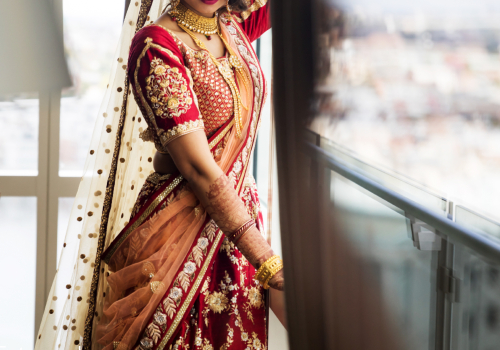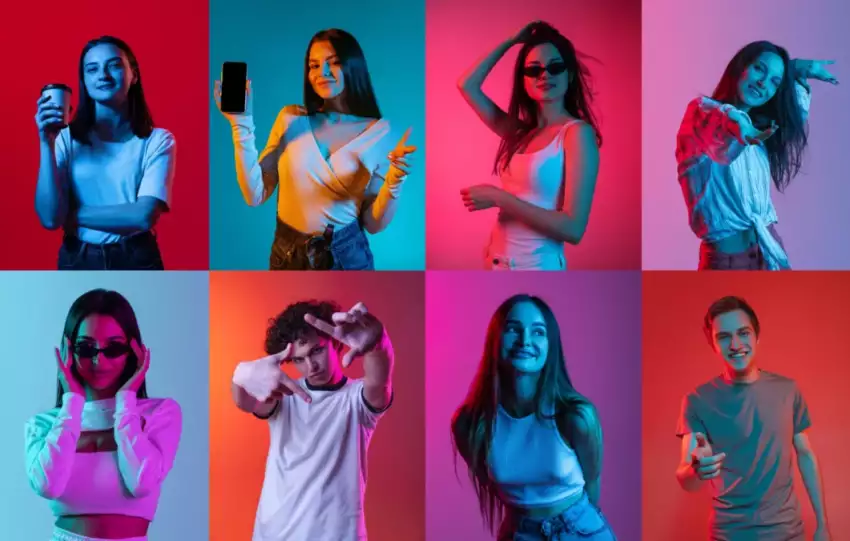Indian traditional clothing has made a stunning resurgence in recent years, captivating the world stage!
From Bollywood-themed events to lavish weddings like the Ambani family’s, these elegant ensembles have been showcased on a global platform.
As the upcoming Deepavali festivities approach, it’s the perfect time to celebrate the beauty and versatility of these timeless pieces.
India’s traditional clothing has not only regained its prominence but has also evolved to cater to contemporary tastes, making it a stylish choice for modern fashion enthusiasts.

Table of contents
- What is Indian Traditional Clothing?
- Indian Clothing’s History
- Saree- The Best Indian Traditional Dress
- 4 Types of Traditional Indian Clothing for Women to Wear This Deepavali
- 3 Indian Traditional Clothing For Men to Wear This Deepavali
- The traditional wedding attire of Indians
- Latest Fashion Trends In India
- Fun Facts About Indian Clothing
What is Indian Traditional Clothing?
India has maintained its traditional clothing, a crucial aspect of its culture, despite globalization. Both men and women wear a variety of traditional clothing.
- The saree is unquestionably the most well-known traditional garment for ladies.
- The national attire for males is the dhoti.
- The dastar, a turban worn by Sikhs, is another distinctive Indian item that is well-known worldwide.
Indian Clothing’s History
Indian clothing has a long history that begins with the Indus Valley civilization in the fifth millennium BC, when cotton was first spun, woven, and dyed. The cotton industry was highly developed, and some of the old methods are still in use today.
People wore both sewn and unstitched clothing throughout the Maurya and Gupta periods, with the main garment being the anariya, which was made of white cotton and fastened at the waist by a sash.
The textile industry of the subcontinent grew throughout time thanks to the new trading routes. Romans purchased indigo for use in dyeing, and silk fabrics were introduced through commerce with China.
Silk and cotton were woven into a variety of regionally specific patterns both in antiquity and now. With the supremacy of mordant dyeing, resist dyeing, and Kalamkari procedures, garment dyeing developed into a form of art in India thanks to the Mughals’ substantial contribution to the country’s growth of its textile industry.

Saree- The Best Indian Traditional Dress
The saree is no doubt the most recognizable item of traditional clothing from the Indian subcontinent.
The word “saree” originated from the word “sattika,” which was used to describe women’s apparel in the earliest Buddhist scriptures.
Around 2000 BC, during the Indus Valley Civilization, the saree first made its appearance. It is constructed of a drape with a length range of 4.5 to 8 meters and a breadth of around 1 meters. Three separate pieces made up the outfit: a bottom garment, a veil, and a chest band.
It is often worn around the waist, with one end exposing the stomach and the other shoulder. Although some Indians believe that the stomach should never be revealed, but an ancient Indian belief holds that the Supreme Being’s navel is where life and creativity originate, which is why the sari displays your navel.
There are various styles and colors of saree’s composed of silk, cotton, ikkat, block-printed, and tie-dyed fabrics.
Various Styles of Indian national dress- saree
There are more than 80 distinct ways to wear a saree. As previously said, the most typical technique involves wrapping the saree around the waist and revealing the belly while wearing the loose end over the shoulder.
Some fashions need a specific length or shape.
Nauvari

It is a variant of the Maharashtrian male dhoti that varies by location and society. This kind of saree is wrapped by holding the fabric lengthwise and placing it in the middle of the back.
The two ends are then coiled around the legs and knotted in front. Women frequently need an additional nine yards of fabric when wearing the nauvari style to cover their shoulders and upper chest.
Assamese

Also known as the mekhela chador, this garment has three primary components: a top, a skirt, and a piece of fabric wrapped around the top and skirt.
Manipuri

It originated from the northeast. Manipuri is a three-piece outfit called an innaphi viel that resembles the mekhela chador.
Maharashtrian

The saree is wrapped around the legs with the center of the fabric put at the back’s center. The ends are then pulled front and fastened. Brahmin ladies dress in this manner.
Bengali Style

There are no pleats in the Bengali fashion.
The saree is wrapped twice around the waist: once counterclockwise and once clockwise. Compared to the loose end used in the conventional method, this one is much longer and may also be used to cover the head.
The family of Indian poet laureate Rabindranath Tagore is where this fashion was first developed.
4 Types of Traditional Indian Clothing for Women to Wear This Deepavali
Indian women historically wear a wide variety of attire, many of which are related to the region’s culture, religion, and climate.
Although Mumbai is becoming the fashion hub of India, many rural regions still have ladies who dress in traditional attire.
Choli and Lehenga

In Rajasthan and Gujarat, this is the traditional attire for ladies, and it is also used for a few folk dances.
It consists of a long skirt called a lehenga, a blouse-like shell called a choli, and a scarf-like item called an odhani.
Anarkali Dress

This Indian look comprises a long shirt that resembles a dress and slim-fitting pants.
In North India, Pakistan, and the Middle East, women wear it mostly. Indian ladies frequently don anarkali outfits for formal meals, yearly festivities, and traditional festivals. These events are what preserve Indian traditional clothing and customs.
The length of anarkali suits can vary, and some of them reach the ground. Many ladies choose to wear a thicker, embroidered anarkali suit to weddings and other festivities.
These outfits’ tops might have long sleeves or be sleeveless.
Salwar Kameez

Punjabi women typically dress in salwar kameez. The outfit consists of a tunic top called a kameez and a pair of salwars which are narrow at the ankles.
A veil is often used by women to hide their shoulders or their head.
Churidar Trousers
South Asian men and women wear these body-fitted Indian traditional clothes.
Churidars are tightened trousers exposing the contours of the leg. They may also have a buttoned ankle cuff at the end and are longer than the leg.
At the ankle, there is some extra length and additional material folded into a bangle-like shape to allow the person to sit comfortably.
3 Indian Traditional Clothing For Men to Wear This Deepavali
Achkan

Achkan is a jacket that has exposed buttons across the length of it. The length of the jacket is often a little below the knees. It has a Nehru-style collar.
The Achkan was traditionally worn with churidars, which are long, tight-fitting pants. The achkan is embellished with traditional Indian embroidery, gotta, and badla.
Lungi

Another traditional Indian clothing is lungi. Lungi’s typically come in two varieties: open lungi and sewn lungi. Stitched Lungi’s ends are sewn together to form a tube-like structure.
People either tuck the lungi in or drape it over the knees, depending on its length.
Dhoti

Dhotis are one of the most popular styles of male traditional Indian attire worn by men in India. Male villagers are the main wearers of the traditional dhoti, which is a four to six-foot-long white or colorful cotton strip.
To hold Dhoti in place, people wrap a fancy or flat, basic belt around their waist.
However, because of its widespread popularity in India, dhotis go by many names in several languages. it’s also referred to as dhotar, Dhotiyu, chadra, pancha, veshti etc.
The traditional wedding attire of Indians
Bridal Traditional Dress
Most brides select a heavily embellished, vibrant red wedding saree as red is the most fortunate hue. Additionally, some brides elect to forgo the saree in favor of a lavishly embroidered lehenga
The saree is the more popular bridal attire in West, East, and South India, whereas the lehenga is more common in North India.

Groom’s Traditional Dress
South Indian grooms typically don the simple or solid-colored dhoti, a traditional garment with embroidered borders. On their lower half, South Indians may also wear a cotton mundu, or draped fabric.
Grooms in North India typically don a sherwani with intricate embroidery or designs. They might also decide to put on a jodhpuri outfit, which consists of a coat, pants, and a vest.
Latest Fashion Trends In India
India has a distinct fashion culture that combines traditional and modern elements.
It involves the fusion of Indian and Western styles, the use of vivid colors, and the usage of Indian textiles in Western apparel.
India has a very diversified population and a huge variety of civilizations. Although it has been affected by many nations, it still has a distinctive fashion culture that is so diverse.
The following are the newest fashion trends in India:
- Indo Western fusion
- Ethnic wear
- Embroidered embellishments
- Color Block Prints
- Long length Gowns

Fun Facts About Indian Clothing
Western clothing cannot compare to the unique beauty and charm of traditional Indian clothing.
These outfits are definitely to die for with their gorgeous fabrics embellished with eye-catching patterns, designs, and embellishments.
Check out the fun facts below to learn more about Indian traditional attire!
- Lehenga and choli became popular in India during the 10th century.
- Dupattas are called chunni, chunri, unni, odhni in India.
- Mundum Neriyathum is the ancient original form of the saree.
- Stitching was not mandatory in ancient India.
- The Mughal invasion introduced the salwar kameez to India.
- Punjabi Suit is another name for salwar kameez.
Every nation and country has a unique method for expressing its culture via traditional dresses and every fashion is distinct, lovely, and a fantastic portrayal of their respective cultures.
Indian Traditional clothing are all about elegance and flair and offer you an unrivaled vibe. There was a period when wearing traditional Indian clothing was ignored.
However, ethnic clothing has recently made a comeback, with a plethora of designers and companies giving you countless possibilities. You might choose a lovely ensemble of salwar and Kurtis if you’re seeking for something cozy and timeless.
When worn with chunky jewelry and a long skirt, your appearance will take on a more bohemian and fashionable feel. Depending on your tastes and sense of style, you may choose your clothing from gorgeous saris to chic floor-length gowns.
We at IQI Global celebrate people from different cultures and all walks of life. Our diverse team of real estate negotiators prioritizes one thing – working hard while playing hard. Join us today!
Continue Reading:


